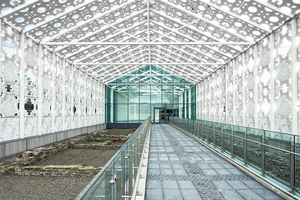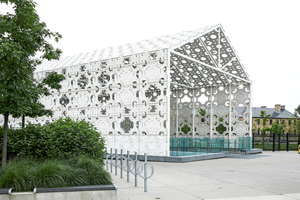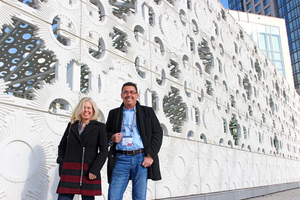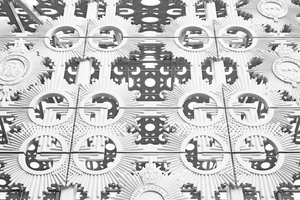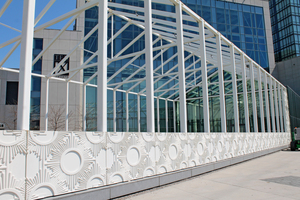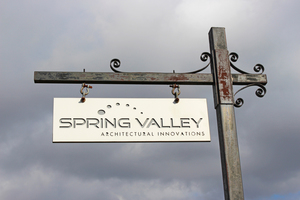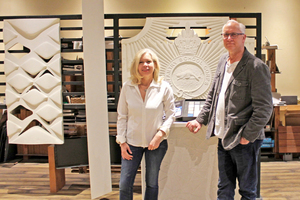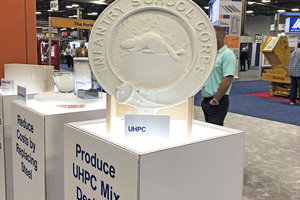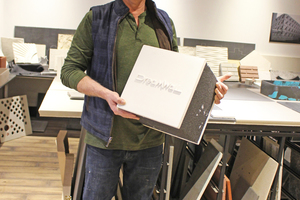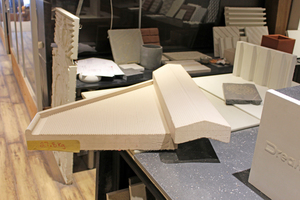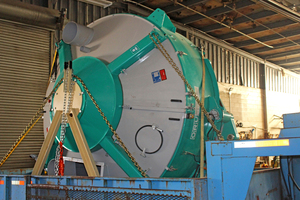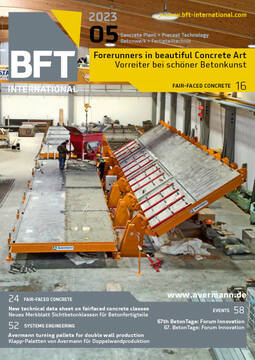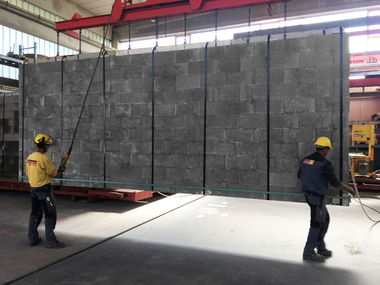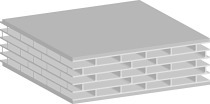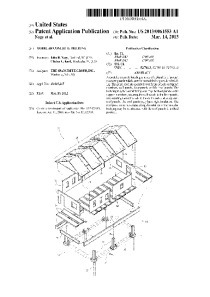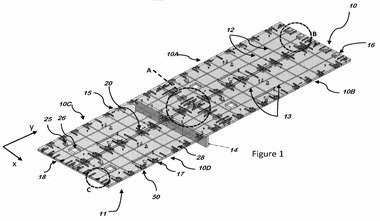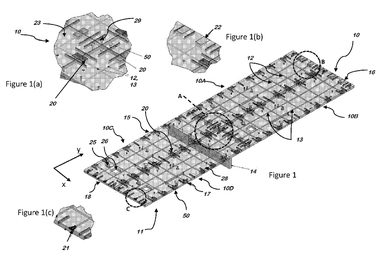Spring Valley Corp – The Forerunners in
“Beautiful Concrete Art”
In the course of a trip to North America, Silvio Schade has recently visited a trade show and precast production plants in Canada and the USA. The BFT editor-in-chief was particularly impressed by the Spring Valley Corp and their flagship project made of UHPC – Hotel X in Toronto.
Spring Valley Corp was originally founded by Eric Sommer in 1982 as a building renovations company. After a restructuring in 2015, it is now known as Spring Valley Corp. owned by Eric Sommer and Patricia Overgaard.
The original focus of the business was to follow in the footsteps of Eric’s father, Murray Sommer, who had a life-long career in the residential home-building business. When Eric started the business he got a foothold in the market by finishing basements and building backyard decks. House framing led to home building which in turn led to taking carpentry contracts with General Contractors. The projects increased in complexity and scope and culminated in the installation of the glulam timber at the Art Gallery of Ontario and Lansdown Stadium. A major turning point came after the restructuring of the company and the addition of Patricia Overgaard as an owner of the business. Eric and Patricia saw an opportunity to start manufacturing Ultra High Performance Concrete and bring it to the market. UHPC is such a versatile product that can be applied in so many ways. The CAAST Brand was created and the development of the concrete technology by Spring Valley Corp has enabled its application as a building cladding and for public art projects. Ultra High Performance Concrete is gaining popularity in Canada and the US, and demand for their product has increased dramatically in the past 3 years.
Wide range of products
Spring Valley Corp manufactures a number of products:
Flat UHPC wall panels in sizes 1220mm x 3660 x 14mm up to 38mm;
Curved and shaped and flat architectural concrete building elements as large as 3.6m x 7.5m x 75mm or as required;
Dream Wall insulated concrete panels: the panels are made with 1 inch of UHPC on the inside as well as the outside and can achieve R values as high as R100;
iClad thermally broken attachment system made from galvanized steel or stainless steel. The iClad system includes cast in threaded anchors, inserts, girts and brackets for a total solution to attach the flat and curved panels to the building.
Spring Valley’s core strength is currently their ability to delivery complex projects that require extensive mold making and thoughtful engineering to bring the building designers intent to fruition.
Eric Sommer explained: ”The flat panel technology that Spring Valley has developed allows us to supply the market with a mass produced panel that has threaded holes in the back of the panel in a 150mm grid to facilitate the attachment of the panel to the building. The growth in sales for the flat panels is expected to be exponential as we are able to demonstrate to developers and designers the beauty of this product as a low cost building cladding solution that has a lifespan of hundreds of years.”
“The current plant has been built over time using our in-house designers and steel fabrication team. The plant is designed to handle increasing demands for more and more volume. Due to the custom nature of our work, we also have CNC machinery for wood and concrete that we use to facilitate mold-making”, added Patricia Overgaard.
The suppliers for the Spring Valley plant equipment are (among others):
Trucent (Water cleaning centrifuge);
Donatoni (Stone CNC machine);
Mixer Systems USA (Concrete mixer);
Murphy (Dust collector);
DMC (Sanding machine and coating machine;
Canadian Crane (Overhead crane);
UTest (Testing equipment) and
SCM (Surface treatment).
“The flat panel technology that Spring Valley has developed allows us to supply the market with a mass produced panel that has threaded holes in the back of the panel in a 150mm grid to facilitate the attachment of the panel to the building. The growth in sales for the flat panels is expected to be exponential as we are able to demonstrate to developers and designers the beauty of this product as a low cost building cladding solution. That’s why we expect to reach our capacity by the end of 2024 at which time we will build a new plant”, Overgaard continued.
Bringing ideas into reality
According to company President Eric Sommer, Spring Valley Corp (SVC) turns owners, architects, and designers “ideas into reality”. The relationship between company and client is simple and straight forward with Sommer explaining that clients come to the company with a concept of what they want to do, with the “expectation that we’ll be able to help them.” An idea, however, is only as good as the plan behind it so, in order to create this reality, SVC sets about using its wide knowledge base and multiple skill sets such as geometric work, energy efficiency reviews and budgetary requirements. The end result is a solution that has been weaved with all of this information in mind. SVC does all the “shop drawings, the engineering, mock-ups, and we can also provide installation services” expains Sommer.
SVC offers a “comprehensive” range of services and products, designed, and engineered for complete building envelopes. The company can work with a client to achieve the best outcomes, regardless of price points and budgets. Its products are suited to all budget ranges, right up to those products where buildings are used as “architectural expression.”
Concrete Art and Applied Science Technology (CAAST)
The primary focus and passion of Eric Sommer and Spring Valley Corp is in the manufacturing of Ultra High Performance Concrete. Their signature product “CAAST” stands for Concrete Art and Applied Science Technology. This is where the skill and innovation within the company really comes into play. For Sommer, this is a truly special product. “This is not just regular concrete, it’s beautiful concrete – it’s concrete art.” On the Applied Science side, Sommer explains that while CAAST concrete “is a piece of art, it’s fully engineered, and it is science in the form of particle density theory and chemistry combined to formulate concrete that can do the job that we need it to do.” Sommer goes on to explain that the technology is the “whole package” and that, with CAAST, “we can achieve budget and we can achieve high-end geometry as well.”
Spring Valley manufactures both Ultra-High-Performance Concrete and High-Performance Concrete – mostly defined by their comprehensive strength, and to be used depending on the project at hand. HPC is between 90 and 120 MPA and UHPC is 120 MPA and over. Sommer explains that HPC is appropriate for the majority of projects however, in situations where a project demands, UHPC can be made. There are multiple factors which influence which concrete is used, such as its flexural strength and its water resistance and, for those at SVC, all factors must be considered. UHPC is made using nano-technology – regular concrete uses aggregates that are ¾ of an inch down to a millimeter or .1 of a millimeter, whereas nanotechnology uses 2 millimeters down to .1 of a nanometer – very tiny particles that achieve high strength and high resistance to water absorption. This innovation has numerous benefits on a project, one of which being the overall weight management. As a result of the product’s high strength, SVC can produce thin concrete profiles which reduce the weight of a cladding system.
Comprehensive range of services and products
Spring Valley Corp offers a comprehensive range of services and products, designed, and engineered for complete building envelopes.
SVC’s ability to make thin concrete profiles is also important when it comes to environmental issues and sustainability. Sommer explains how concrete has received “a bit of a bad rap” due to the carbon footprint created by the manufacturers of Portland cement coupled with auxiliary issues such as mining and transport. According to Eric Sommer, there is a simple way to reduce the carbon footprint of concrete; use less of it. “If we can make a building using concrete, but we can do this by using much less of it and formulating it in such a way that it has more durability, then we’ve kind of hit it on multiple fronts.” Simply put, reducing consumption, and improving the longevity of the product increases the sustainability of the whole industry. Next to water, concrete is the most consumed product by humans on this planet. “I believe the most effective way to reduce the carbon footprint of concrete is to use less of it. Concrete is going to be with us for a long period of time until somebody finds something that will replace that – let’s find better ways to use concrete so that it can be a more sustainable product. Every product that you use in a construction project has to be used to its own best-optimized use… as we gain knowledge of how each one of these affects the environment, and how each one can contribute durability to a project, we can optimize the use of all of these products to be more sustainable.”
Outstanding reference project Hotel X
The company recently completed work on Hotel X, a luxury hotel on the grounds of Toronto’s Exhibition Place with exposed archaeological ruins below it. This project, according to Sommer, was a “perfect application for UHPC.” The design required that the concrete panels be structural while also perforated, as the designer wanted to achieve a high level of detail on the surface of the panels to communicate the message behind the structure. This meant that SVC had to create molds with very fine details in them, and the mix had to fill these with minimal amounts of air bubbles. Sommer explained that a double-sided pattern is “difficult to achieve in any medium but probably most achievable with UHPC.” The strength of the concrete made the attachment system “very simple”, according to Sommer, with each panel being held up by quarter-inch structural screws. In addition to this, UHPC was also very important for Hotel X due to the project’s exposure to the elements. Sommer explains that, due to the volatile nature of the surroundings, the benefits of UHPC were really front and center. “The freeze-thaw action of the elements has a huge effect on anything they would’ve used, so UHPC will have high durability in that application.”
Situated on the New Fort archeological site, the design, awarded through an international competition, consists of two thematic elements: a steel structure that evokes the original volume of the East Enlisted Men’s Barracks (EEMB) once located above the existing uncovered foundation; and secondly, a veil of Ultra-High Performance Concrete (UHPC) panels, providing a narrative through military history, emblematic of the regiments residing on site. The pavilion consists of over 400 ornate UHPC panels viewed from both the interior and exterior of the structure. The design draws inspiration from the rich history of the New Fort and the EEMB site and the men and women responsible for establishing Toronto’s military legacy. Each regiment which garrisoned the New Fort between 1840 and 1893 is represented by its unique regimental badge.
To produce the voided, ornate veil for the Insignia installation, architect Steven Beites needed a material that was both robust and refined to recreate the fine detail of the regimental badges displayed on the 494 panels. Ultra-High Performance Concrete (UHPC) was ultimately chosen because it met the requirements for appearance and durability and could be produced locally by Spring Valley Corp.
The highly mouldable nature of CAAST renders both high quality aesthetic details and cladding panels, all of which are high strength and weather resistant. The robustness of UHPC comes from a denser matrix that transfers stress very effectively while also restricting water and chemical infiltration because of an ultra-low coefficient of permeability. The mechanical properties of UHPC allow for more slender profiles, reducing mass and embodied energy. When combining long service life and lower mass, this solution aids in the development of environmentally sustainable design. For this project, the master moulds were made using high-density foam, and rubber was used to create the working moulds. The wall panels needed to be double-sided, meaning having a relief pattern on both sides. This posed a challenge because the design would not allow the part to be made in a double-sided mould and cast vertically.
Co-Owner Patti Overgaard said: “We overcame this by creating a mechanical connection using stainless steel formed welded wire and placing a completed part onto a freshly poured part. Powder coated steel plates were embedded into the pieces to allow the panels to be screwed to the steel frame. The majority of the panels are perforated with voids up to 55% of the area, and the weight of each panel ranges from 290 – 545 kilograms (640-1200 pounds). We poured between six to nine panels a day and the project took approximately one year to complete. Upon completion, an anti-graffiti finish was applied to the panels.“
The 494 panels cover an area of 1,064 square metres (11,455 square feet). The largest panels are 2 metres x 1.2 metres x 114 millimetres thick (6.6 feet x 4 feet and 4.5 inches). White cement, white sand and titanium dioxide were used to create the brilliant white finish. The largest aggregate used in this mix was 2 mm in diameter.
Next steps for Spring Valley Corp
So, what is next for those at Spring Valley Corp? It seems as though the benefits of collaboration and an innovative take on one of the oldest building materials on the planet will ensure the company goes from strength to strength. A new project, in collaboration with Malcolm Hachborn of CPCI, has led to the development of an insulated wall system called Dreamwall which uses UHPC on both the inside and outside.
Both Eric Sommer and Patti Overgaard, the owners of SVC, are very excited about the future of SVC and CAAST Concrete. Sommer says of the venture, “without the support of other industry partners it wouldn’t be possible to do what we’re doing.” With the exponential growth in sales and plans for a new facility in 2024, the outlook for SVC is a bright one with Overgaard going on to explain that the company is a “forerunner in the thin concrete world and architects are now taking notice. We believe we have a really bright future.”
CONTACT
Spring Valley Corp
735 Trinity Rd.
Jerseyville, Ontario
L0R 1R0/Canada
+1 905 -648-1881
PROJEKT-STECKBRIEF
Bauherr: Hotel X
Architekt: Studio Kimiis / S. Beites
Bauingenieur: Tall Pines Engineering Ltd.
Montage: LaFontaine Iron Works Inc.
Betonfertigteil-Lieferant: Spring Valley Corp.

